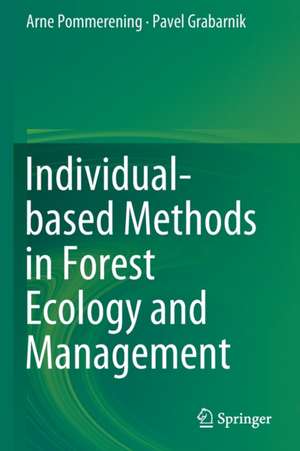Individual-based Methods in Forest Ecology and Management
Autor Arne Pommerening, Pavel Grabarniken Limba Engleză Paperback – 28 sep 2020
| Toate formatele și edițiile | Preț | Express |
|---|---|---|
| Paperback (1) | 533.85 lei 6-8 săpt. | |
| Springer International Publishing – 28 sep 2020 | 533.85 lei 6-8 săpt. | |
| Hardback (1) | 709.58 lei 6-8 săpt. | |
| Springer International Publishing – 27 sep 2019 | 709.58 lei 6-8 săpt. |
Preț: 533.85 lei
Preț vechi: 628.06 lei
-15% Nou
Puncte Express: 801
Preț estimativ în valută:
102.15€ • 111.31$ • 86.08£
102.15€ • 111.31$ • 86.08£
Carte tipărită la comandă
Livrare economică 23 aprilie-07 mai
Preluare comenzi: 021 569.72.76
Specificații
ISBN-13: 9783030245306
ISBN-10: 3030245306
Pagini: 411
Ilustrații: XV, 411 p. 186 illus., 60 illus. in color.
Dimensiuni: 155 x 235 mm
Greutate: 0.59 kg
Ediția:1st ed. 2019
Editura: Springer International Publishing
Colecția Springer
Locul publicării:Cham, Switzerland
ISBN-10: 3030245306
Pagini: 411
Ilustrații: XV, 411 p. 186 illus., 60 illus. in color.
Dimensiuni: 155 x 235 mm
Greutate: 0.59 kg
Ediția:1st ed. 2019
Editura: Springer International Publishing
Colecția Springer
Locul publicării:Cham, Switzerland
Cuprins
Foreword; Dan Binkley.- Preface.- Acknowledgements.- 1. Introduction.- 2. Theories and concepts in individual-based forest ecology.- 3. Theories and concepts in individual-based forest management.- 4. Spatial methods of tree interaction analysis.- 5. Spatial and individual-based modelling.- 6. Principles of relative growth analysis.- 7. Human disturbances and tree selection behavior.- A. Qualitative forest description.- B. Survey protocol for the establishment of permanent forest research plots.- C. Brief Introduction to the R language.- References.- Index.
Notă biografică
Arne Pommerening works as Professor in Mathematical Statistics Applied to Forest Sciences at the Swedish University of Agricultural Sciences (SLU) in Umeå. He is a theoretical forest scientist and biometrician specialised in quantitative forest ecology and management. Arne Pommerening is particularly known for his research in woodland structure analysis and modelling, spatio-temporal dynamics of plant point patterns, individual-based modelling, plant growth analysis and methods for quantifying and monitoring biodiversity. More recently he has also developed an interest in the analysis of human behaviour in selecting trees. Much of his research involves combinations of field trials and computer-based simulation experiments.
Pavel Grabarnik is a Professor of Mathematical Modelling in Ecology at Pushchino University in Russia. Currently he serves as the Director of the Pushchino Scientific Centre of Biological Research of the Russian Academy of Sciences and heads the Laboratory of Ecosystems Modelling. His research work includes ecological modelling focussed on the spatial structure of forest ecosystems. His main achievements in statistics are in parameter estimation and hypothesis testing for spatial point processes. Pavel Grabarnik has also developed computational tools for different aspects of applications in spatial statistics.
Pavel Grabarnik is a Professor of Mathematical Modelling in Ecology at Pushchino University in Russia. Currently he serves as the Director of the Pushchino Scientific Centre of Biological Research of the Russian Academy of Sciences and heads the Laboratory of Ecosystems Modelling. His research work includes ecological modelling focussed on the spatial structure of forest ecosystems. His main achievements in statistics are in parameter estimation and hypothesis testing for spatial point processes. Pavel Grabarnik has also developed computational tools for different aspects of applications in spatial statistics.
Textul de pe ultima copertă
Model-driven individual-based forest ecology has emerged in the 1990s and has given rise to a wealth of publications. At the same time, individual-based methods in forest management have been refined in a number of different countries and steadily grow in importance. For the first time this book integrates three main fields of forest ecology and management, i.e. tree/plant interactions, biometry of plant growth and human behaviour in forests. Individual-based forest ecology and management is an interdisciplinary research field with a focus on how the individual behaviour of plants contributes to the formation of spatial patterns that evolve through time. Key to this research is a strict bottom-up approach where the shaping and characteristics of plant communities are understood to be mostly the result of interactions between plants and between plants and humans. Written in a highly accessible style, the book provides essential information on theories and concepts of individual-basedforest ecology and management and introduces point process statistics for analysing plant interactions. This is followed by methods of spatial modelling with a focus on individual-based models. The text is complemented by key concepts of modern plant growth science. Finally new methods of measuring, analysing and modelling human interaction with trees in forest ecosystems are introduced and discussed. For better access and understanding, all methods introduced in this book are accompanied by example code ready to use in the statistical software R and by worked examples. Additional technical details are given in three appendices.
Caracteristici
The integration of methods in individual-based forest ecology is an eye-opener for readers who otherwise would need to read through scattered publications using quite different style, terms and notations Numerous R code and worked examples allow easy access and transparency of methods Three detailed appendices provide additional material on technical matters Adopts an accessible style allowing non-specialists complete understanding Describes the process of gaining new knowledge in ecology through data analysis and modelling
